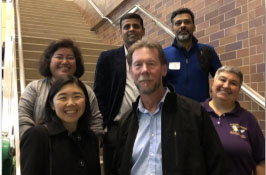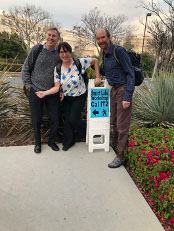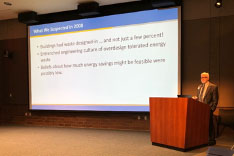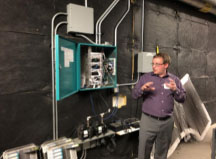University of California Irvine Smart Labs Workshop With Design-Build Add-On

Smart Lab Accelerator Partners from NASA's JPL.
The University of California Irvine (UCI), a Better Buildings Smart Labs Accelerator and Higher Education Challenge partner, hosted a two-day Smart Labs and Design-Build Workshop on January 29-30, 2019.
The workshop brought together more than 100 attendees from other higher-education institutions, national laboratories, and associated stakeholders, to share best practices in laboratory energy management and safety.
Other Smart Lab Accelerator partners in attendance included: the National Aeronautics and Space Administration's (NASA) Jet Propulsion Laboratory (JPL), Los Alamos National Laboratory, Argonne National Laboratory, Pacific Northwest National Laboratory, National Renewable Energy Laboratory (NREL), UCI Health, and Lawrence Berkeley National Laboratory.

Figure 1. Dan Doyle (Grumman Butkus) and Smart Labs Accelerator partners Nicole Ellison and Otto Van Geet (NREL) head to the Smart Labs Workshop.
Wendell Brase, UCI's Associate Chancellor of Sustainability, kicked off day one of the workshop, presenting on their Smart Labs Initiative and what they have learned since the program's inception in 2008. UCI has demonstrated a paradigm shift in lab energy management, achieving energy savings of more than 60% in Smart Lab buildings while lowering maintenance costs. Its early leadership in this space was instrumental in the development of the Better Buildings Smart Labs Accelerator.
In achieving this remarkable success, Brase recommended workshop attendees "challenge all accepted design practices" to ensure safety and energy savings are optimized. Matt Gudorf, assistant director of energy, engineering, and inspection at UCI, then went into detail on a Smart Labs program, saying that Smart Labs is more than a project. "A program puts in place a process and procedures, manages change, documents the expectations and results."
Dick Sun, and Jay Seong, of UCI's environment, health, and safety (EH&S) department, in coordination with Tom Smith of 3Flow, next discussed lab safety and ventilation management.
The team explained how UCI's EH&S staff utilize multiple methods to verify, monitor, and maintain lab safety before, during, and after lab modifications. They also presented on new work conducted at UCI to test the operation of Smart Labs modifications, lab air supply, and ventilation effectiveness (VEFF). The team explained "how and where air is introduced into the lab and exhausted from the lab is much more important to lab safety than the air changes per hour."

Wendell Brase (UCI) answers questions about developing a high-performance laboratory building.

Joseph Fleshman talks about the laboratory demand-based ventilation control system.
On the afternoon of day one, Allison Paradise, CEO and founder of My Green Lab, spoke to the behavioral side of sustainable lab operations and how organizations can bring a culture of sustainability through science. Attendees also had the chance to hear from a principal investigator and graduate students at UCI, followed by a tour of UCI's laboratory facilities.
Day two of the workshop focused on design-build project delivery and its application to new construction of laboratories, Smart Lab retrofit projects, and integrated facility renewal.
Brian Pratt, UCI's Campus Architect, and Rebekah Gladson, a former UCI campus architect and now president of rggroup global, presented on UCI's approach to the Design-Build process for laboratories. The top benefits discussed included a reduction in overall project schedule, change orders, and team resolution of issues. They talked in detail about the development of the request for proposal process and ways to value quality of design.
Presentations from the workshop are also available.